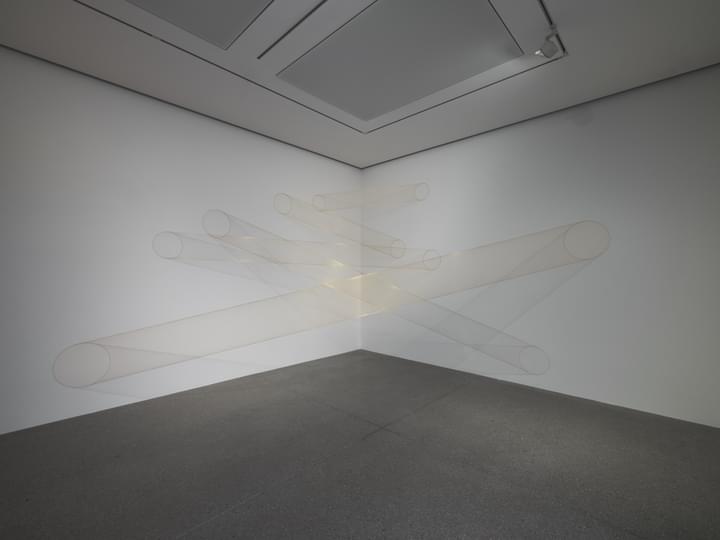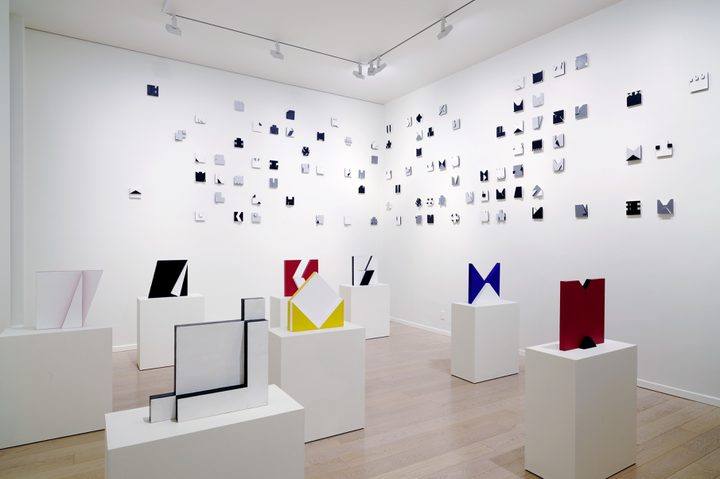
Lygia Pape, Seoul (2024)
Lygia Pape
22 March – 25 May 2024
My concern is always invention. I always want to invent a new language that’s different for me and for others, too […] I want to discover new things. Because, to me, art is a way of knowing the world […] of getting to know the world.
White Cube Seoul is pleased to present an exhibition of works by Brazilian artist Lygia Pape (1927–2004), marking the gallery’s inaugural presentation of the artist and the first-ever presentation of her work in Seoul. A seminal figure in the Concrete art movement and a founding member of its splinter group, the Neo-Concrete movement, Lygia Pape played a defining role in the development of contemporary art in Latin America. This exhibition traces the trajectory of Pape’s experimental five-decade career, showcasing some of the artist’s most renowned works across drawing, sculpture and installation, through which she pioneered new forms of geometric abstraction that questioned the spatial dynamics between artwork and viewer.
In the early 1950s, while studying at the Museu de Art do Rio de Janeiro, Pape, together with her artistic peers Aluíso Carvão, Lygia Clark and Hélio Oiticica, formed the experimental collective Grupo Frente. Closely associated with the European Concrete movement, the group rejected the Brazilian modernist conventions of the era – which tended towards the figurative – instead engaging with a form of geometric abstraction untethered from observed reality. Pape’s wall-mounted series of ‘Relevos’ (‘Reliefs’) are emblematic of the artist’s early experimentations with constructivist forms, displaying an almost machine-made technical precision. Created with tempera and enamel paint on fibreboard, Relevo (1954-56) features four triads of elevated pyramidal forms, strategically arranged in the corners of the board. Each uniformly sized, the pyramids are hued a vivid orange on one ridge with a contrasting black on the opposing side. Hybridising the planar surface of the wooden canvas with projected three-dimensionality, the ‘Relevos’ introduce a perceptive paradox – the sequenced geometric forms are fused to a bidimensional plane, creating the illusion of floating independently within space.
Reiterating the linear elements and experimental arrangements of her ‘Relevos’, Pape began developing a series of drawings in ink titled ‘Desenhos’('Drawings’) during the latter 1950s and early ’60s – a period marking the transition between her affiliation with Grupo Frente and her later commitment to Neo-Concrete values. The ‘Desenhos’ thus exhibit composite qualities, combining the extreme rationalism of Concrete art with the ‘expressive potential’ of its successor. In these drawings, precise linear trajectories intersect with impulsive stippled markings, giving rise to spherical and angular forms that convey a sense of kineticism. The striations collide, shift, weave and fracture one another with the spontaneity of sketched markings, setting the field in motion. This dynamic is at once evocative of the illusionistic optical effects of Op Art as well as the fluctuations found in musical compositions – with parallel lines eliciting musical staves and negative areas marking caesuras within soundless orchestrations.
Pape’s pivotal role in the Brazilian Neo-Concrete movement in 1959 signalled a shift in her artistic practice, shaped by a liberation from static form and a move towards heightened sensuality through the interaction of objects in real-time and space. Livro Noite e Dia (Book of Night and Day) (1963–76) is one of Pape’s renowned series of part-book-part-sculptural works where the artist combines methods of painting, relief and bookmaking to chronicle temporality. Comprising 365 singular wooden units, Livro Noite e Dia records the shifting passage of light over the course of a year – the units, carved individually from square boards with each segment reattached to their corresponding square, are arranged orthogonally and painted in monochromatic shades of black, white and grey, collectively forming a linear measure of time. Coinciding with her involvement with the film group Cinema Novo, the components of Livro Noite e Dia could equally be reworked as granular units, fragmented or cut, akin to the process of editing a film, with each individual part representing a single frame in a movie.
Following the disbandment of the Neo-Concrete movement in the early 1960s, Pape continued her explorations with basic forms – those of the circle, the triangle and the square. Part of a series of geometric sculptures which utilises the square as a structural foundation, KV256 (1961–98) arose from the artist’s contemplations on the reconfigurable units found in the ‘Livro’ series. Constructed from loose chrome-plated iron sections that have been cut and re-inserted, KV256 re-orders geometric elements to build and dismantle the square base shape. The detachable elements afford endless possibilities, facilitating the reconfiguration of the work into myriad arrangements –positioned next to, in front of, behind, or on top of the work. Manipulating metal with suppleness, the sculpture transcends the weight of its industrial composition to embody both geometric abstraction and organic fluidity. The reflective chrome surface interacts with shifting directional light, creating a work that occupies the intersection of solid and voided space, the material and metaphysical.
In the latter decades of her career, Pape devoted herself to exploring the interstices within and around geometric forms, establishing a dialogue between the cerebral and the intuitive. Belonging to her sculptural series, ‘Volante’, which translates as ‘steering wheel’ or ‘flying’, Pape’s 1999 sculpture features copper-plated iron wheels seemingly poised between stillness and motion. Pape termed this threshold dimension ‘magnetised space’, a conceptual framework that saw volume as inextricable from space, which she perceived to be interwoven through an ‘endless skein’, applicable to the multifarious interconnectivity of the urban fabric, the relationship of the body to space, the viewer to the artwork.
Few works embody Pape’s magnetised space more than her immersive geometric installations, ‘Tteias’ – a semantic play on the Portuguese words ‘teia’ (meaning ‘web’) and ‘teteia’, connoting a person or entity of grace. Comprised of metallic threads and produced by the artist from 1976 through to the early 2000s, featured in this exhibition, Ttéia 1,B (2000) delineates volume through the accumulation of gold threads, giving rise to luminous cylindrical columns. Configured in a staggered formation, these columns traverse the corner of the gallery, intersecting one another. By virtue of light interacting with the surface of the threads, Pape’s ‘Tteias’ manifest a spatial and luminal domain, wherein movement becomes a foundational element in shaping the fabric of cognitive reality. Evoking the woven geometries of her formative ‘Tecelares’ prints and ‘Desenhos’ drawings, the ‘Ttéia’ series has emerged as one of Pape’s most celebrated works.
One of the final works created by Lygia Pape before her death in 2004, But I Fly (2001), a poetic reinterpretation of the word ‘Butterfly’, is a testament to the sublime simplicity with which the artist emphasised the primacy of sensorial experience and its role in the everyday. The film features the artist herself, framed both face-on and in profile, partially obscured by a red fan whose languid, undulating movement ushers the viewer into a deep hypnotic state. Enlisting a minimal colour palette of black, ivory and red – the film foregrounds its acoustic elements, capturing the sonorous calls of birds native to Brazil and immersing us in the temperate milieu that the artist considered her lifelong home. The exhibition marks 20 years of Lygia Pape’s passing, commemorating an artist whose liberation and reconciliation of volume, space and geometric abstraction leaves behind a legacy that expands the parameters of human perception and spatiality.
Create an Account
To view available artworks and access prices.



















